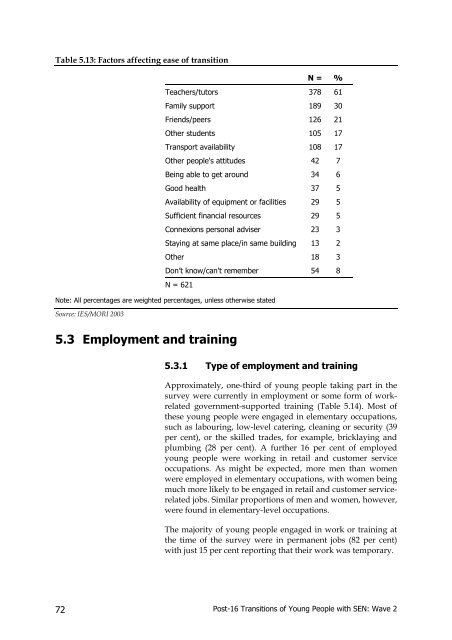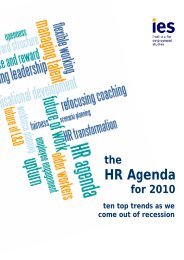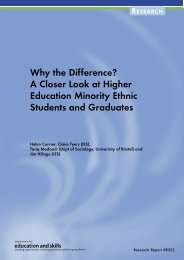Post-16 Transitions: a Longitudinal Study of Young People with ...
Post-16 Transitions: a Longitudinal Study of Young People with ...
Post-16 Transitions: a Longitudinal Study of Young People with ...
You also want an ePaper? Increase the reach of your titles
YUMPU automatically turns print PDFs into web optimized ePapers that Google loves.
Table 5.13: Factors affecting ease <strong>of</strong> transition<br />
N = %<br />
Teachers/tutors 378 61<br />
Family support 189 30<br />
Friends/peers 126 21<br />
Other students 105 17<br />
Transport availability 108 17<br />
Other people's attitudes 42 7<br />
Being able to get around 34 6<br />
Good health 37 5<br />
Availability <strong>of</strong> equipment or facilities 29 5<br />
Sufficient financial resources 29 5<br />
Connexions personal adviser 23 3<br />
Staying at same place/in same building 13 2<br />
Other 18 3<br />
Don’t know/can't remember 54 8<br />
N = 621<br />
Note: All percentages are weighted percentages, unless otherwise stated<br />
Source: IES/MORI 2003<br />
5.3 Employment and training<br />
5.3.1 Type <strong>of</strong> employment and training<br />
Approximately, one-third <strong>of</strong> young people taking part in the<br />
survey were currently in employment or some form <strong>of</strong> workrelated<br />
government-supported training (Table 5.14). Most <strong>of</strong><br />
these young people were engaged in elementary occupations,<br />
such as labouring, low-level catering, cleaning or security (39<br />
per cent), or the skilled trades, for example, bricklaying and<br />
plumbing (28 per cent). A further <strong>16</strong> per cent <strong>of</strong> employed<br />
young people were working in retail and customer service<br />
occupations. As might be expected, more men than women<br />
were employed in elementary occupations, <strong>with</strong> women being<br />
much more likely to be engaged in retail and customer servicerelated<br />
jobs. Similar proportions <strong>of</strong> men and women, however,<br />
were found in elementary-level occupations.<br />
The majority <strong>of</strong> young people engaged in work or training at<br />
the time <strong>of</strong> the survey were in permanent jobs (82 per cent)<br />
<strong>with</strong> just 15 per cent reporting that their work was temporary.<br />
72<br />
<strong>Post</strong>-<strong>16</strong> <strong>Transitions</strong> <strong>of</strong> <strong>Young</strong> <strong>People</strong> <strong>with</strong> SEN: Wave 2

















